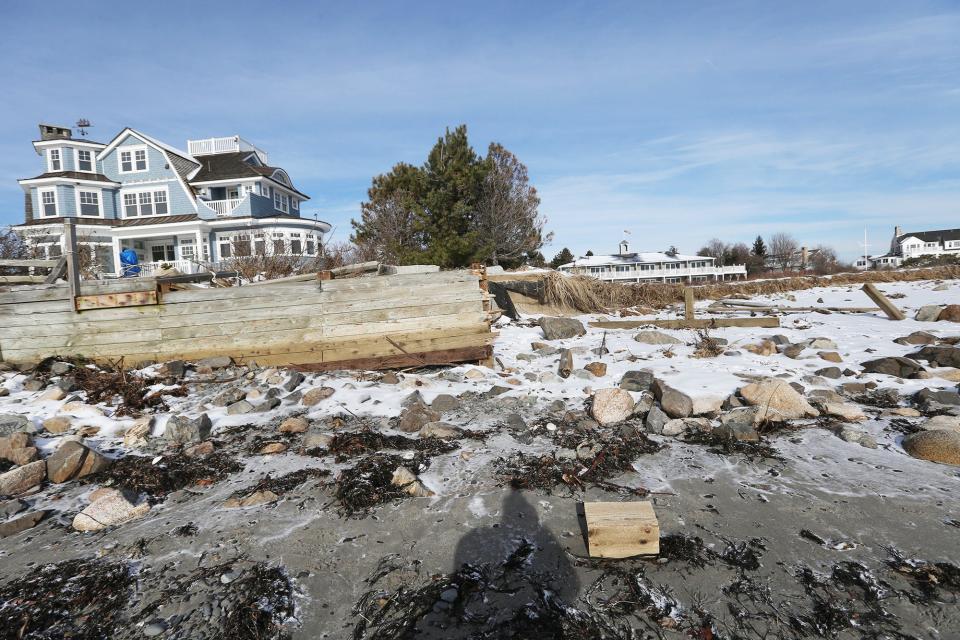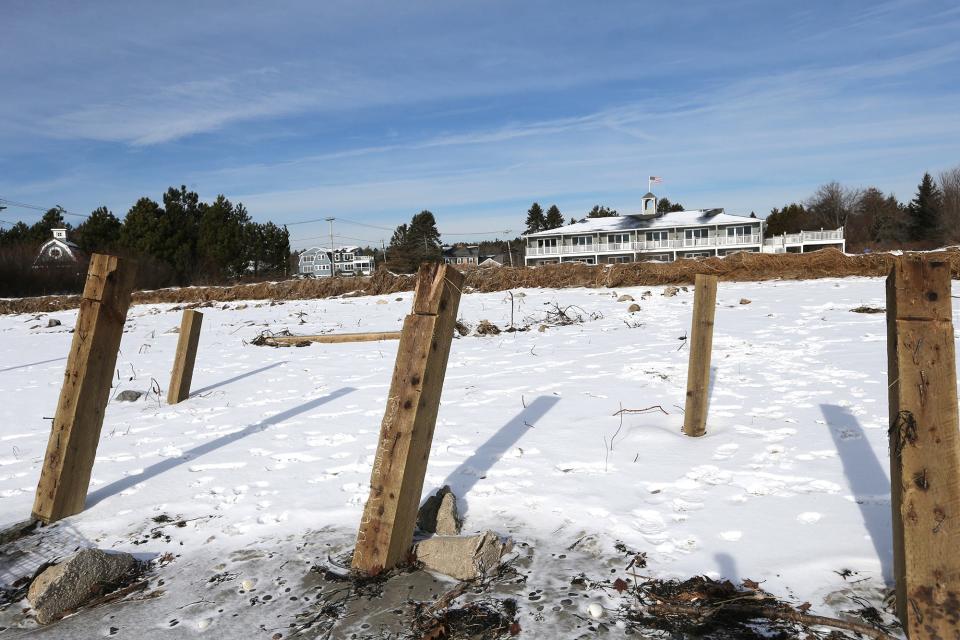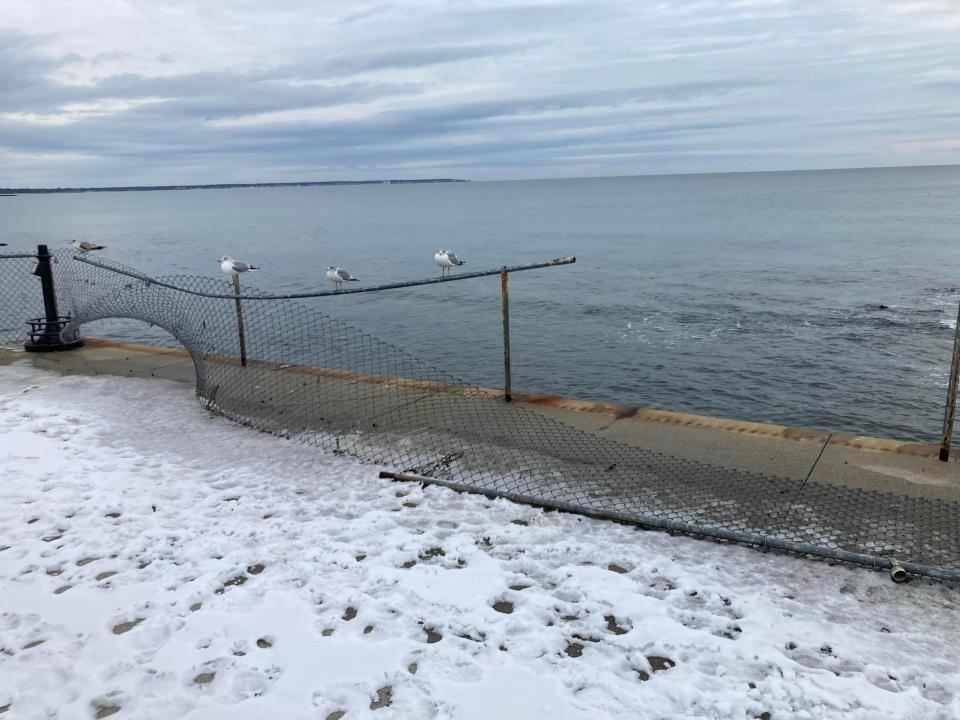Maine coastal communities struggle to recover from storms that caused millions in damage
Local leaders are asking residents to be patient and mindful as coastal communities coordinate their responses to the widespread damage caused by two heavy storms earlier this month.
“The cleanup and temporary repairs will progress slowly over the next several months,” Kennebunk Town Manager Heather Balser said in an email on Jan. 26. “There is still a high level of service that needs to be delivered to the remainder of the town during the winter months.”

The storms, which occurred on Jan. 10 and Jan. 13, damaged dunes, sidewalks, walls and roads up and down the southern Seacoast. Towns are seeking funding from both the Maine Emergency Management Agency and the Federal Emergency Management Agency.
'Everything’s just ruined' York and Hampton beaches face devastating flood damage
Kennebunk reports more than $2 million in storm damage
During a meeting last week, Balser told the Kennebunk Select Board the town suffered approximately $2 million in damage as a result of the storms, which dropped significant rain on the region and sent tides soaring inland.
Town engineer Chris Osterrieder told the Select Board the first storm on Jan. 10 weakened infrastructure at the beach and left it vulnerable to the second storm that followed three days later.
“Where we saw most of the damage was on the supporting infrastructure – the sidewalks or the sections of roads that just couldn’t handle that wave of water coming across them,” Osterrieder said. “As it got contained, it scoured and eroded the roads.”

As a result of federal emergency funding over the years, the town has been able to build some “really strong walls” that “did just fine” during the recent storms, Osterrieder said. However, there was still a problem at such sites, he added.
“They’re not high enough to stop the water,” he said.
The town is taking both short-term and long-term approaches to repairing the damage. In the coming months, the town will remove many of the hazards created by the storms.
“Once removed, the town will patch these locations, so they are safe and passable,” Balser said. “Locations where this cannot be accomplished prior to the summer season will be barricaded off.”
Some passages, such as Great Hill Road and Boothby Avenue, are now open for traffic to pass through, according to the town’s website. However, Beach Avenue is only partially open, as it is closed between Bruen Place and Harris Lane. The Bridle Path, from Western Avenue to Lower Sea Road, however, is closed, and residents are urged not to attempt to walk there or access it in any way.
Currently, the town is working with the state and federal emergency management agencies to secure funding for repairing local beach areas and restoring them to “pre-disaster conditions,” according to Balser. Once funding figures are known, town officials will be able to discuss what portions of the municipal budget will be needed for the effort, she added.
Previous story: Without a dune and seawall, Kennebunk's Seaside Inn owner fears the next big storm
Seawall holds up, Cliff Walk and stone wall need repairs in York
York Town Manager Peter Joseph said his town’s municipal infrastructure fared better than other communities in the last two storms. He said the drainage upgrades around Short Sands Beach and Railroad Avenue helped prevent flood water from causing serious damage at that location.
Private homes saw significant flooding on certain streets despite the new sections of the seawall at Long Sands Beach. What the seawall did do, he said, is prevent serious damage to the roadway.
“Long Beach Seawall held up really well,” Joseph said. “In a different configuration, the entire roadway could have been gone.”
Two sections of town roads and protective buffers took significant damage, including the southern-most section of the Cliff Walk, according to Joseph.
Joseph said initial estimates indicate the repairs will be about $500,000.
“We’re committed to pricing it out,” Joseph said. “I don’t think anyone’s looking to abandon it.”
The other notable piece of infrastructure that took significant damage in the storm was the stone wall at Ocean Avenue Extension, which saw 6 to 8 feet taken out by the storm. He said a permanent repair to the wall would be approximately $1 million, though that is only an estimate.
Storm left 'wake of destruction,' 14 homes uninhabitable in Wells
Other communities also are assessing the damage of the January storms and are seeing efforts that will last into the weeks and months ahead. On Jan. 30, for example, members of the Kennebunkport Select Board were expecting to meet at Goose Rocks Beach General Store in the morning and tour the area and discuss the storms’ aftermath.
In Wells, Town Manager Michael Pardue said the second storm “left a wake of destruction along our entire coastal area,” rendering 14 homes uninhabitable and leaving as many as 30 other properties to undergo assessment from the damage they received.
“Several of our homeowners along the beach have been severely impacted,” Pardue said. “These property owners and their contractors will be in ‘building mode’ well into the summer, and likely beyond. We ask that they be given consideration by those curious to see the damage incurred.”

Pardue said the dollar amount of damage is still being calculated, but he added that the final figure is anticipated to reach a “multimillion amount.”
With some of the damage, he said, there may be more than meets the eye.
“A prime example is when a roadway or seawall is undermined,” he said in an email on Jan. 29. “The structure may look fine to the casual eye, but when viewed more closely by a structural engineer, which the town employs in situations like this, it may be determined that there is little supporting the structure, necessitating major repairs.”
Pardue said town personnel worked tirelessly to safeguard the public both during and following the storms. Roads were only reopened after a thorough assessment of the state of their surfaces, abutting shoulders, and other factors, he said.
“Some roads, such as a large section of Webhannet Road, remain closed today due to the degree of damage incurred,” Pardue said. “Some seawalls and abutting areas have been temporarily shored up, while others have been cordoned off while further assessment is performed.”
The town is working closely with state and federal officials to seek disaster funding for repairs, Pardue added. He said FEMA officials already have visited Wells to discuss the storms’ impacts and are anticipated to visit again.
More: Kittery leaders assess damage from coastal storms, flooding
Pardue said mitigation, and not just repairs, is in the town’s future.
“Our plan is to promote the rebuilding of compromised areas, while also giving consideration on how best to mitigate the impact of future high-impact coastal storms,” he said.
The proposed redesign and reconstruction of the Drakes Island bridge – a project that has been in the design phase for the past year or so – is one example of such needed visioning, according to Pardue. As engineers consider the design of the bridge, they will take into account the projected sea-level rise over the next roughly 75 years, he added.
As these restoration efforts continue, Pardue is asking residents and visitors to “please be mindful of signs identifying areas that may still be under review for damage or under construction.”
“Please be respectful of our efforts to keep you safe as we work to make our coastline better and stronger,” he said.
Homelessness on the rise in Kennebunk: What town officials are doing to help
Ogunquit fire chief calls storm 'damaging, but not disastrous'
In Ogunquit, Fire Chief Russell Osgood described the storms as “damaging, but not disastrous,” in that nobody was injured, and no properties were destroyed. The parking lot at the main beach and Marginal Way also were impacted by the weather.
Dunes were “significantly damaged, with good portions of them washed away,” Osgood said.
“We’ve lost 10 to 12 feet of dunes in some places,” he added.
Damage is estimated to be around $2.5 million, according to Osgood. As with other communities, Ogunquit too will be seeking funds from the Federal Emergency Management Agency.
Some good news: damage was not severe enough to cause, or threaten to cause, the Ogunquit River to run through and cut off the main beach.
“No danger there at all,” Osgood said.
Osgood added a plan is not yet in place regarding the dunes, as the town is currently researching and assessing them and deciding whether they can build themselves back up or will need time and funds to restore them.
Marginal Way, a scenic attraction for residents and tourists alike, should be back to normal by the summertime, according to Osgood.
“I think things will be pretty normal this summer,” he said. “We intend to make everything safe by summer.”
This article originally appeared on Portsmouth Herald: Maine coastal communities struggle to recover from storms

